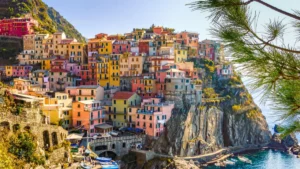Rocks and primeval forests: You must have seen these 8 natural wonders in Germany
Pure nature – from glaciers to rock formations and primeval forests to river bends: In Germany there are so many natural beauties that you have to see. We present eight highlights.
The one with one
Provision – at no extra cost to you! More info
Short journey, great landscapes: There are hundreds of answers to the question of where the most spectacular natural sites in the country are located. To ease the agony of choice, we show eight wonders of nature – from Rügen to Saxon Switzerland to the Alps. Ideal for a short trip with a long-term memory effect.
Zugspitze: Highest mountain with three glaciers
It is the summit in the truest sense of the word: At a height of 2962 meters, the Zugspitze near Garmisch-Partenkirchen is Germany’s highest mountain. Three glaciers – the northern Schneeferner, the southern Schneeferner and the Höllentalferner belong to the massif of the Zugspitze. Nowhere else in Germany can you get closer to the eternal ice than on the Northern Schneeferner – all year round.
In winter there is a ski area with guaranteed snow, in summer you can hike, toboggan on snow fields with Zipfelbobs, simply walk the interactive glacier adventure trail (also suitable for children) and reach a viewing platform at dizzying heights. Those who are not experienced mountaineers with alpine experience can take the cog railway or cable car and float up to the summit station.
The panoramic view of more than 400 Alpine peaks in four countries alone – from Germany to Austria, Italy and Switzerland – is worth it. This is also available from the summit restaurant, which is equipped with floor-to-ceiling panoramic windows and serves dishes from the aforementioned Alpine countries.
Saar loop: breakthrough valley with treetop path
Germany’s most beautiful river bend completes a 300 degree U-turn: the Saar meanders between Merzig and Mettlach around a wooded ridge on which the ruins of Montclair Castle are enthroned. Although the two Saarland towns are only about two kilometers apart as the crow flies, the romantic detour of the river is almost ten kilometers.
The most beautiful view of the Saarschleife is from the “Cloef” vantage point at 180 meters above sea level. There is also a 1.2 kilometer long treetop path with a 42 meter high tower, which guarantees breathtaking views of the depths. Hikers, walkers and Cyclists will not only find many paths along the Saar loop, but also a ferry that takes you to the other bank.Tip: Get up early, because in the morning light wafts of mist rise up the valley – a magical atmosphere!
Externsteine in the Teutoburg Forest: Mysterious stone towers
40 meter high sandstone rocks in bizarre shapes: Externsteine are the name of the stone towers near Horn-Bad Meinberg in the Teutoburg Forest, which have fascinated people for thousands of years. Here nature meets culture on the rock. Geologists can explain how the stone giants were formed. A good 70 million years ago, sandstone layers are said to have been pressed vertically during the course of the folding of the Teutoburg Forest and over the years have been exposed by erosion and formed in bizarre ways.
However, traces such as stairs, grottos and caves hewn into the rock, which people have left there for thousands of years, still puzzle scientists. Archaeologists found pottery from the Middle Ages nearby, from which they concluded that monks lived there.
However, whether the Externsteine served as Christian sanctuaries or pagan-Germanic places of worship is disputed. What is certain, however, is that special forces are at home in this magical place in North Rhine-Westphalia. For these reasons, too, the Externsteine are among the most remarkable natural and cultural monuments in Central Europe.
Spreewald: amazing water landscape
Would south of Berlin Parrots and monkeys screech instead of whistle whistling and white storks clatter, you could almost imagine yourself in the Amazon region here. The more than 1000 km long water and forest labyrinth of the Spreewald in Brandenburg is one of the most extraordinary water landscapes in Europe. Countless arms of the Spree form canals that are connected to old Sorb villages and lonely farmsteads.
The animal and plant world in the Spreewald is unique, the swamp area has been an international biosphere reserve since 1990. Although there are no jaguars, sloths or anacondas, there are otters, beavers, red deer, wild boar, kingfishers, 113 species of mussels and snails, 48 species of dragonflies and grass snakes. The people who have lived here for more than 600 years also exude a touch of the exotic. The Sorbs come from a Slavic minority and, like the indigenous inhabitants of the Amazon, have retained their own language and culture.
The nature of the Spreewald invites you to many adventures: Traditional boating with a ferryman, who punts through the widely branched network of rivers. Water hiking with a canoe or on foot on the European hiking trail E 10, which leads across the entire Spreewald. Or cycle along the 250-kilometre cucumber cycle path.
Saxon Switzerland: Adventures in the Elbe Sandstone Mountains
Bizarrely shaped rock formations and table mountains made of sandstone: Germany’s Monument Valley is not in the Wild West, but in the Wild East. To be more precise, in Saxony, southeast of Dresden, in the Saxon Switzerland National Park. The striking sandstone rocks glow red in the evening and morning light and spread a magical atmosphere.
However, with an age of 80 million years, the canyons and rock towers are significantly younger than their counterparts in the USA. But the area is less dangerous: Instead of scorpions and rattlesnakes, animals such as polecats, beavers, slowworms and 250 bird species live here.
The most famous of all rock needles is called “Bastei”, a narrow reef that drops 194 meters vertically to the Elbe. The “Basteibrücke” leads on to the ruins of the former Felsenburg Neurathen. Climbers can prove themselves on more than 1000 peaks such as the Schrammsteinen, the Affensteinen or in the Schmilka area. A 1200 km long network of paths leads hikers through the rocky landscape – such as the 112 km long Malerweg, which also leads past where Caspar David Friedrich painted his famous “Wanderers above the Sea of Fog”.
Chalk cliffs of Rügen: White Coast in the Baltic Sea
It is the landmark of the Baltic Sea island, which is also the largest in the country: the rugged chalk coast with its white rocks. With the green of the surrounding forests and the turquoise blue of the sea, it has a fascinating effect on people.
Their majestic grandeur inspired many painters and poets as early as the 19th century, including the most important romanticist Caspar David Friedrich, who competed with the original chalk cliffs with what is probably his most famous painting, “Chalk Cliffs on Rügen”.
The highest elevation is the 118 meter high Königsstuhl, followed by the Viktoria viewpoint, which lies on a chalk cliff to the south. A ten-kilometer hiking trail leads from the port city of Sassnitz over the hills on the high banks to the Königsstuhl. More panorama is not possible!
Breitachklamm: Fantastic rock gorge
The most impressive rock gorge in Central Europe is in Tiefenbach near Oberstdorf in the Allgäu: the Breitachklamm. Its rock walls drop vertically up to 100 meters. Below, the Breitach thunders over rocky banks, gurgles in deep pools and the white spray from the roaring water leaves fine droplets in the air, with which the light plays its games.
The more it rained, the more impressive the rushing of the crystal-clear water through the gorge. Well-developed hiking trails lead over a kilometer in the direction of the rock fall. Depending on their mood, visitors can hike through the Breitachklamm in one to two and a half hours on different paths from medium to easy – the path is secured and safe.
Loreley rocks on the Rhine: legendary romantic place
At kilometer 555 on the Rhine, many ships have already been caught: at this dangerous bottleneck in the gorge near Sankt Goarshausen, which is up to 25 meters deep and has many dangerous eddies and shoals, several Rhine boatmen rammed into the rock, capsized and drowned.
The reason for her inattentiveness is said to have been the Loreley – a dazzling beauty who sat on a 132 meter high, rugged rock, sang and combed her long blonde hair. Her appearance and her songs are said to have been so beguiling that the Rhine boatmen looked up at her in fascination and forgot to pay attention to the dangerous places in this gorge.
The Rhine still poses a challenge for shipping here today and the beautiful Loreley is said to show itself on the slate summit on moonlit nights. If you want to see them, climb up the stairway and enjoy the fabulous view of the Middle Rhine Valley with its steep vineyards and the castles of Katz and Rheinfels. The rock made of dark argillaceous slate can be admired less strenuously from the St. Goar district on the left bank of the Rhine, from the Maria-Ruh vantage point near Urbar or from a ship.
Source: https://www.focus.de/reisen/urlaubs-check/diese-8-naturwunder-in-deutschland-muessen-sie-gesehen-haben_id_137079920.html


